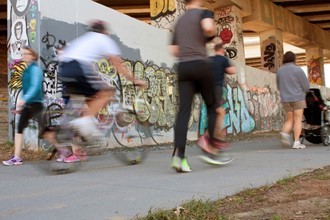“In situations where a specific hazard has not been experienced, planning provides the opportunity to anticipate conditions and systematically identify potential problems and workable solutions.[i]”
 The Atlanta BeltLine is a walkable and bikeable path that connects neighborhoods, providing residents and visitors an attractive alternative to driving. When complete, the Atlanta Beltline can unify once divided areas, engendering greater community connectedness and economic viability. It weaves under, over, and through a multitude of overpasses, footbridges, and tunnels. As in any city, a significant feature is simultaneously an asset and a potential hazard. These types of structures are “vulnerable critical facilities” that should be included in emergency risk assessments and mitigation planning.[ii] Bridges of the BeltLine is a mixed-methods study to understand how the BeltLine can be used as an emergency management asset.
The Atlanta BeltLine is a walkable and bikeable path that connects neighborhoods, providing residents and visitors an attractive alternative to driving. When complete, the Atlanta Beltline can unify once divided areas, engendering greater community connectedness and economic viability. It weaves under, over, and through a multitude of overpasses, footbridges, and tunnels. As in any city, a significant feature is simultaneously an asset and a potential hazard. These types of structures are “vulnerable critical facilities” that should be included in emergency risk assessments and mitigation planning.[ii] Bridges of the BeltLine is a mixed-methods study to understand how the BeltLine can be used as an emergency management asset.
The project’s findings could break new ground on how to analyze the emergency use of similar pathways, at a time when many cities are looking at rails-to-trails projects. As such, this project is responsive to the United Nations’ sustainable goals nine “Build resilient infrastructure, promote inclusive and sustainable industrialization and foster innovation[iii]” and eleven “Make cities and human settlements inclusive, safe, resilient and sustainable.[iv]” The work of Bridges of the BeltLine is scalable to encompass the fully developed Atlanta BeltLine eventually, and its findings can be transferable to other cities around the nation and globe which have similar multi-use pedestrian pathways.
This preliminary study, specifically the findings from the BeltLine Bridge audit, lays the foundation for the future development of IoT Bridge monitoring that will provide knowledge of bridge structural changes over time as well as enhance traffic awareness and safety for pedestrians. When the initial people flow phase is complete, we will address automotive + pedestrian traffic via a coordinated deploy of a wireless sensor network.
Survey on Your Use of the Atlanta Beltline
The Atlanta Beltline can unify once divided areas, engendering greater community connectedness and economic viability. Georgia Tech’s Center for Advanced Communications Policy is interested in understanding (a) which communities are being served by the Atlanta BeltLine and (b) how it can be used as an emergency management asset. Your responses will be used to describe who is on the Beltline, when, reasons, and frequency of visits.
This research is being funded by Georgia Tech’s Executive Vice President of Research Small Bets Seed Grants. The goal of this research is to “Make cities and human settlements inclusive, safe, resilient, and sustainable.”
The survey is open to Atlanta Beltline visitors aged 18 or older.
Take the survey online at http://bit.ly/ATLBeltLine
Scan the QR Code to Take the Survey on your Mobile Device.
If you would like to take the survey via telephone, email Salimah@cacp.gatech.edu to schedule a date and time.
Project Update February 2021
The project has received Institutional Review Board (IRB) approval to conduct the 22 item intercept survey which include question options to assess whether commuters are using the BeltLine to connect to public transportation and whether the use of the BeltLine has supplanted other transportation modes. Based on the survey questions, the results should supply valuable insights that can inform several domains, including emergency management, community development and underserved communities, sustainability, and resiliency. In addition, there have been two important changes in technical development. We are primarily pursuing a low-power, low-cost doppler radar system for people detection, and we have shifted focus from LoRaWAN to NB-IoT for data backhaul. The knowledge generated by Bridges of the BeltLine is anticipated to 1) provide an evidence base to inform future development of low-cost, low power integrated sensor network for measuring the impact of multiuse trails on the adjacent communities, and 2) increase knowledge among local and state emergency managers about how the BeltLine can be used as an emergency response asset.
Research Project Progress Report
Principal Investigators:
Salimah LaForce, Center for Advanced Communications Policy
Jeff Evans, Georgia Tech Research Institute, CDAIT
Scott Gilliland, Interactive Media Technology Center
This research is made possible by a grant from Georgia Tech’s Executive Vice President of Research, Small Bets Seed Grants program.
[i] FEMA. (2010). Comprehensive Preparedness Guide (CPG) 101, Version 2.0, Developing and Maintaining Emergency Operations Plans. Available at https://www.hsdl.org/?abstract&did=736560
[ii] FEMA. (2013). Mitigation ideas: A resource for reducing risk to natural disasters. Available at www.fema.gov › fema_mitigation_ideas_final_01252013
[iii] UN 17 Sustainable Global Development Goals. Available at https://www.un.org/development/desa/disabilities/envision2030-goal9.html
[iv] UN 17 Sustainable Global Development Goals. Available at https://www.un.org/development/desa/disabilities/envision2030-goal11.html

